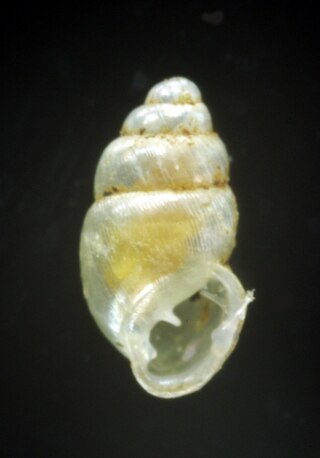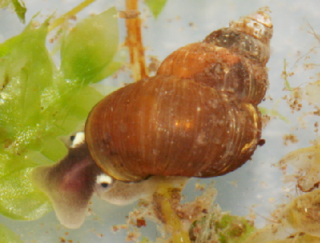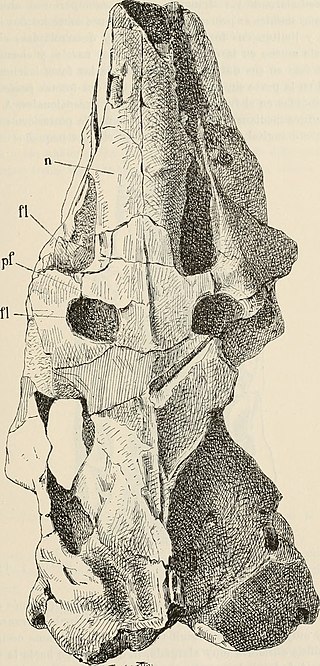
Helix is a genus of large, air-breathing land snails native to the western Palaearctic and characterized by a globular shell.

Mystacinidae is a family of unusual bats, the New Zealand short-tailed bats. There is one living genus, Mystacina, with two species, one of which could have possibly become extinct in the 1960s. They are medium-sized bats, about 6 centimetres (2.4 in) in length, with grey, velvety fur.

Terrestrial animals are animals that live predominantly or entirely on land, as compared with aquatic animals, which live predominantly or entirely in the water, and amphibians, which rely on aquatic and terrestrial habitats. Some groups of insects are terrestrial, such as ants, butterflies, earwigs, cockroaches, grasshoppers and many others, while other groups are partially aquatic, such as mosquitoes and dragonflies, which pass their larval stages in water.

Latia is a genus of very small, air-breathing freshwater snails or limpets, aquatic pulmonate gastropod molluscs in the superfamily Chilinoidea.

Allognathus is a genus of air-breathing land snails, terrestrial pulmonate gastropod mollusks in the family Helicidae, the true snails. The genus is endemic to the Balearic Islands being present in all major islands and in several small islets. The genus colonized the archipelago from the south-eastern Iberian Peninsula during the Middle Miocene, throughout a land-bridge connection. The different species belonging to Allognathus live in crevice rocks or under stones.
Ptychalaea is a fossil genus of very small, air-breathing land snails, terrestrial pulmonate gastropod molluscs in the family Gastrocoptidae.
Zilchogyra paulistana is a species of air-breathing land snail, a terrestrial pulmonate gastropod mollusk in the family Helicodiscidae.

Helicodiscidae is a family of small air-breathing land snails, terrestrial pulmonate gastropod mollusks in the superfamily Punctoidea.
†Filholiidae is an extinct family of fossil air-breathing land snails, terrestrial pulmonate gastropod mollusks in the superfamily Clausilioidea.
Zodiolestes is a genus of mustelids, now extinct, which existed during the Miocene period.

Carychium is a genus of very small air-breathing land snails, terrestrial pulmonate gastropod mollusks in the family Ellobiidae.
Balanerodus is an extinct monospecific genus of alligatorid crocodylian. Fossils have been found from the Fitzcarrald Arch in the Peruvian Amazon and the La Victoria Formation of the Honda Group in Colombia and date back to the Friasian and Laventan regional South American land mammal ages of the Middle Miocene.

Klikia is a genus of fossil air-breathing land snails, a terrestrial pulmonate gastropod molluscs in the family Elonidae.

Urticicola is a genus of air-breathing land snails, terrestrial pulmonate gastropod mollusks in the subfamily Trochulininae of the family Hygromiidae, the hairy snails and their allies.

Blanfordia is a genus of terrestrial gastropod mollusks in the family Pomatiopsidae. They are land snails which have an operculum.

Fukuia is a genus of amphibious freshwater snails and land snails with an operculum, gastropod mollusks in the family Pomatiopsidae.
Pleurofusia is an extinct genus of sea snails, marine gastropod molluscs in the family Drilliidae.

Gastrocoptidae is a family of minute, air-breathing land snails, terrestrial pulmonate gastropod molluscs in the superfamily Pupilloidea.

Hemihegetotherium is an extinct genus of hegetotheriid notoungulate that lived from the Middle to the Late Miocene of what is now Argentina.
Aiteng marefugitus is a species of fully terrestrial sea slug found only on the Ulong Island of Palau. The species name is derived from Latin, meaning "fled from the sea".












